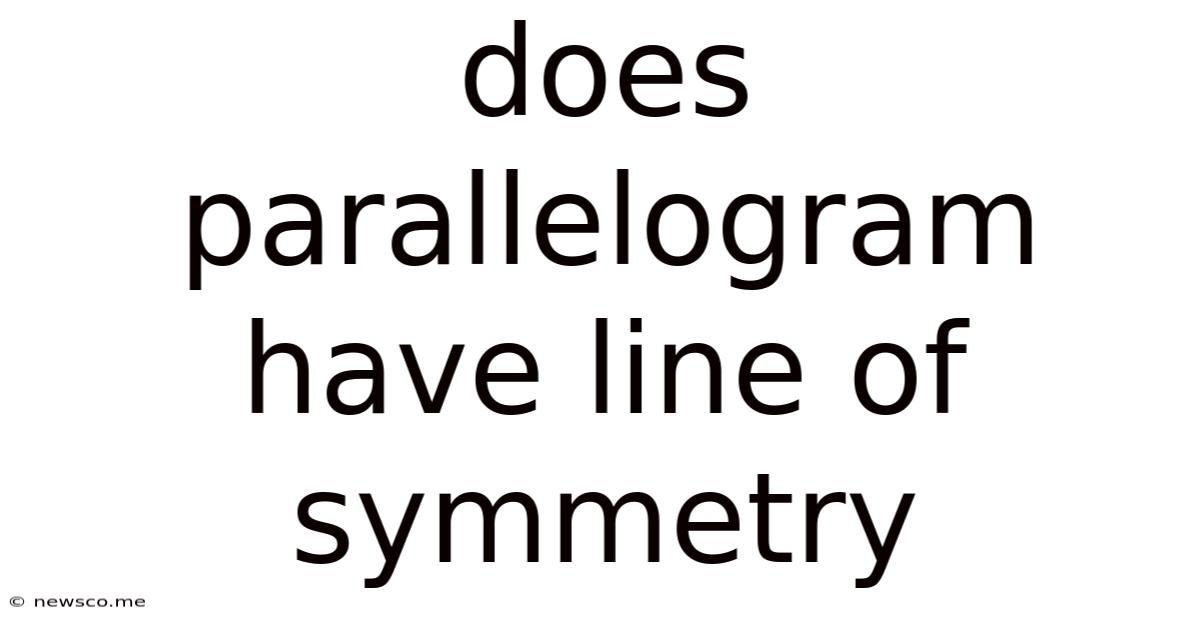Does Parallelogram Have Line Of Symmetry
News Co
Apr 19, 2025 · 5 min read

Table of Contents
Does a Parallelogram Have a Line of Symmetry? Exploring Symmetry in Quadrilaterals
Symmetry, a captivating concept in geometry and beyond, refers to a balanced and proportionate arrangement of elements within a shape or figure. Understanding symmetry is crucial in various fields, from art and design to engineering and physics. This article delves into the intriguing question: Does a parallelogram possess a line of symmetry? We'll explore the definition of symmetry, different types of symmetry, and analyze the properties of parallelograms to definitively answer this question. We'll also examine related concepts and extend our understanding to other quadrilaterals.
Understanding Lines of Symmetry
A line of symmetry, also known as a line of reflection, is a line that divides a shape into two identical halves. If you were to fold the shape along this line, the two halves would perfectly overlap. This means that each point on one side of the line has a corresponding point on the other side at an equal distance from the line. A shape can have multiple lines of symmetry, or none at all.
Types of Symmetry
While this article primarily focuses on lines of symmetry (reflectional symmetry), it's important to acknowledge other types of symmetry:
-
Rotational Symmetry: A shape exhibits rotational symmetry if it can be rotated less than 360 degrees about a central point and still look identical to its original position. The order of rotational symmetry is the number of times the shape looks identical during a 360-degree rotation.
-
Point Symmetry: A shape has point symmetry (also known as central symmetry) if it can be rotated 180 degrees about a central point and still look identical. This is a special case of rotational symmetry of order 2.
Exploring the Properties of Parallelograms
Before determining if a parallelogram has a line of symmetry, let's review its key properties:
- Opposite sides are parallel: This is the defining characteristic of a parallelogram.
- Opposite sides are equal in length: The lengths of opposite sides are congruent.
- Opposite angles are equal: The measures of opposite angles are congruent.
- Consecutive angles are supplementary: The sum of the measures of any two consecutive angles is 180 degrees.
- Diagonals bisect each other: The diagonals intersect at a point that divides each diagonal into two equal segments.
Does a General Parallelogram Have a Line of Symmetry?
Now, let's address the central question: Does a parallelogram have a line of symmetry? The answer is generally no. A typical parallelogram, unless it's a special case (which we'll discuss below), lacks any lines of symmetry. Visualize a parallelogram that isn't a rectangle or rhombus; you won't find a line that divides it into two perfectly congruent halves. Folding it along any line will not result in a perfect overlap.
To further understand why, consider the implications of having a line of symmetry. If a parallelogram did have a line of symmetry, it would imply that the opposite sides (which are already equal in length) would be symmetrically placed with respect to the line. This additional constraint would inevitably transform the parallelogram into a more specialized quadrilateral.
Special Cases: Rectangles and Rhombuses
While a general parallelogram doesn't have a line of symmetry, certain special types of parallelograms do exhibit this property:
Rectangles
A rectangle is a parallelogram with four right angles. A rectangle possesses two lines of symmetry. These lines pass through the midpoints of opposite sides. Folding a rectangle along either of these lines will result in perfect overlap.
Rhombuses
A rhombus is a parallelogram with four equal sides. A rhombus has two lines of symmetry. These lines are the diagonals of the rhombus. Folding a rhombus along its diagonals will result in a perfect overlap of the two halves.
Squares
A square is a special case that is both a rectangle and a rhombus. Consequently, a square possesses four lines of symmetry: two that connect the midpoints of opposite sides, and two that lie along its diagonals.
Lines of Symmetry vs. Other Properties
It's crucial to distinguish between lines of symmetry and other properties of parallelograms. The presence of equal sides or equal angles doesn't automatically imply the existence of a line of symmetry. Symmetry is a more specific geometric property related to reflectional equivalence.
Applying Symmetry Concepts to Other Quadrilaterals
Let's extend our analysis to other types of quadrilaterals:
-
Trapezoids: Generally, trapezoids do not have lines of symmetry. However, an isosceles trapezoid (a trapezoid with two equal non-parallel sides) has one line of symmetry, which is perpendicular to the parallel sides and passes through their midpoints.
-
Kites: A kite has one line of symmetry that connects the vertices of the two pairs of adjacent equal sides.
-
Irregular Quadrilaterals: Irregular quadrilaterals, lacking any specific properties like parallel sides or equal angles, generally do not possess lines of symmetry.
Conclusion: Symmetry and the Parallelogram Family
In summary, while a general parallelogram does not possess a line of symmetry, special cases like rectangles, rhombuses, and squares exhibit one or more lines of symmetry. Understanding symmetry is essential for classifying and analyzing geometric shapes. This exploration demonstrates the interconnectedness of geometric properties and highlights the subtle yet significant differences within the family of parallelograms. By recognizing the conditions under which symmetry arises, we gain a deeper appreciation for the elegance and order present in geometric figures. Further exploration into more complex shapes and higher-dimensional geometry would reveal even richer concepts of symmetry. This knowledge is invaluable in diverse applications, from creating aesthetically pleasing designs to solving complex engineering problems.
Latest Posts
Related Post
Thank you for visiting our website which covers about Does Parallelogram Have Line Of Symmetry . We hope the information provided has been useful to you. Feel free to contact us if you have any questions or need further assistance. See you next time and don't miss to bookmark.